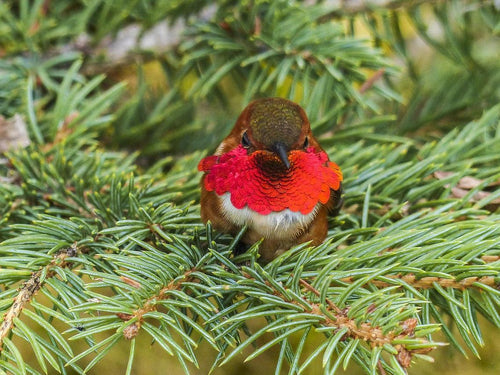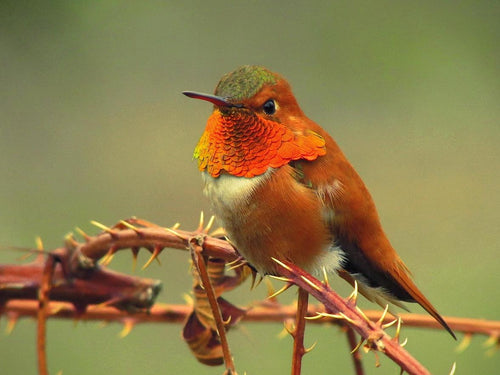Hummingbird Migration: Everything You Want to Know
TTNatureTeam
The hummingbird migration is a marvel to witness. These tiny birds take on a magnificent feat, traveling unbelievable distances to warmer weather during the winter and back again to breed in the spring.
They are solo-travelers, but significant numbers can be seen flying overhead and even taking rest at backyard oases.
Why is there a hummingbird migration? When and how do they undertake this impressive journey? Keep reading to find out.
Why Do Hummingbirds Migrate?
Instinct drives the hummingbird migration. Over a great span of time, evolution has conditioned these birds to a tee to migrate on time and to the correct location. Changes in daylight, such as the angle of the sun and the duration of daylight hours, trigger the instinct to begin the migration route.
There are many reasons this takes place. Migration is vital due to seasonal weather changes, leading to a lack of food sources and increased difficulty maintaining a normal body temperature. Due to a lack of dense plumage, hummingbirds struggle to maintain warmth in temperatures below fifty degrees Fahrenheit, meaning a move to warmer regions is necessary.
 The instinct to migrate is powerful in hummingbirds. Three unbelievable facts prove this.
The instinct to migrate is powerful in hummingbirds. Three unbelievable facts prove this.
1. Juvenile hummingbirds travel alone, their first migration included. They leave on time and find their wintering grounds, even though they have never been there before.
It feels like a mystery as to how they know the migration route without ever being shown. They are said to have ‘innate migration maps’ and a ‘built-in compass’ which help them accomplish their first journey.
2. The timing of the hummingbird migration proves the power of the instinctual drive to move. Hummingbirds precisely time their departures, arriving at their destination at the exact same time each year. All migratory hummingbird species exhibit a mere one-to-two-day margin of error. Luckily for us, this makes it easy to be ready to witness this event!
Their precision is especially impressive when we consider that their triggers, such as changes in weather, are not precisely consistent year after year. An instinctual drive to migrate helps them maintain punctuality. This is something difficult to wrap our minds around, yet it is present in many species.
3. Caged birds are reported as becoming restless at the time of the hummingbirds’ migration. They often lean to one side of the cage, depending on the season, in an attempt to leave and move north or south.
They additionally experience an increase in appetite at this time, as if they need to prepare for the long journey. If your hummingbird puts on weight in late fall and early spring and begins to act restless, this is why.
When Do Hummingbirds Migrate?
Autumn hummingbird migration takes place in August for hummingbird species with longer journeys and in September for those already residing further south.
The spring migration begins as early as February and continues until late spring, again depending on the distance traveled. Males often migrate first, followed by females and then juveniles.

How Far Do Hummingbirds Migrate?
As mentioned above, hummingbirds’ migration distances vary depending on the location of the breeding grounds. Those residing in Canada, for example, have a lengthier migration pattern than those living in the southern U.S. Regardless, hummingbirds travel great distances, sometimes even spanning thousands of miles.
A 2025 spring hummingbird migration map and more information about hummingbird migration patterns and destinations are linked here.
Red-Throated Hummingbird Migration Route
Let’s take a look at an example of a migration route of a North American hummingbird species. A prime example is the Red-Throated Hummingbird. This bird’s breeding ground, where it spends its summers, is throughout eastern North America. Its territory ranges from Canada to the Gulf of Mexico.
Its migration distance depends on its starting location, but spans up to over five hundred miles. Some of these routes are over open water, where there is nowhere to stop and rest. They winter in Mexico and Central America in clearings in forests and locations with plenty of blooming flowers.
Hummingbird Migration Behavior
Preparation for migration takes place roughly a month before departure. Hummingbirds complete their one-way migration pattern in eighteen to twenty-two hours. Their speedy flight requires serious stores of energy.
For this reason, they gorge themselves, intending to gain up to forty percent of their regular body weight. This, paired with frequent stops to top off on nourishment and energy along the way, aids in the bird’s ability to keep moving and reach its destination on time
Upon arrival at their wintering grounds, they molt their winter feathers and enjoy the warmer, often tropical, climate. Before returning in the spring, they gorge once again in preparation for the journey.
How To Attract Hummingbirds During Migration
Hosting a stopover site for hummingbird species is a fantastic birdwatching opportunity and a great help for our feathered friends. They are in dire need of food, water, bathing opportunities, and rest. Providing resources has the potential to make your backyard a frequented stopover location.
 Things you can do to attract migrating hummingbirds to your backyard include:
Things you can do to attract migrating hummingbirds to your backyard include:
· Planting native flowers: Hummingbirds enjoy red and orange blossoms, plus plants such as bee balm, honeysuckle, and more. Research what native plants attract hummingbirds in your region and plant them abundantly!
· Providing perches: Perches provide hummingbirds with an opportunity to rest, which is much needed during their arduous flight. No need to be fancy- hummingbirds aren’t picky!
· Providing nesting materials: Spring is breeding season, and hummingbirds appreciate the gift of nesting materials. Consider soft, organic fibers, and avoid using synthetic materials or anything treated with chemicals.
· Providing Additional Food Sources: Nectar makes up the majority of the hummingbird’s diet.
An intelligent hummingbird feeder is recommended. This lets you observe the bird’s habits and interactions with the feeder. Many even connect to an app on your phone to give you further insight and alert you when the feeder needs attention, such as when it must be refilled!
Hummingbirds also feed on insects. Hang overripe fruit near the bird feeder to attract fruit flies as a secondary food source.
· Create bathing pools: Hummingbirds enjoy and need a good bath once in a while. Providing a fountain or other clean water source allows them the opportunity to do so.
More About Hummingbirds
Now that we know about hummingbird migration, let’s learn some hummingbird facts!
· The Bee Hummingbird is the world’s smallest bird, measuring about two inches in length and weighing about half an ounce. It is native to the Caribbean island of Cuba and feeds on the nectar of flowers and bugs.
· They are the only birds that fly both forward and backward. They have a rare wing structure and range of motion that allows backward travel. While most birds flap their wings up and down, hummingbirds move their wings in a figure-eight motion, allowing them to perform unusual, highly skilled movements.
· Hummingbirds cannot smell but hear and see better than humans. They even see ultraviolet light. They have specialized eye structures and brain processing that aid their spectacular eyesight.
· Feather coloration of hummingbirds is not pigment-based. The color comes from a cellular structure in the top layer of the feather. The color we see varies and is determined by the angle at which the sunlight reaches the feather, causing the feather to reflect the light, creating the iridescent coloration.
Conclusion
As we can see, hummingbird migrations are some of the longest of all small birds. This hefty migration is necessary due to changes in weather and a decline in important food sources.
The tiny hummingbird is mighty in its ability to travel in a short amount of time and sometimes over open water, which provides no respite to rest and refuel. Migratory hummingbirds are no joke and are a group of species that deserve great respect!




